Conservation Biology, exam 2, rww 2
1/95
There's no tags or description
Looks like no tags are added yet.
Name | Mastery | Learn | Test | Matching | Spaced |
|---|
No study sessions yet.
96 Terms
Biodiversity and Variation (what types/levels)
-Within Individuals(Genetic Level) (homologous chromosomes, genes and gene loci, alleles, homozygosity v. heterozygosity)
- Species Level
- Within and Among Populations
“Gene pools are becoming diminished and fragmented into gene
puddles”
Foose, 1983
Genetic drift
change in the frequencies of alleles in a population resulting from sampling error in drawing gametes from the gene pool to make zygotes and from chance variation in the survival and/or reproductive success of individuals; results in NONADAPTIVE EVOLUTION
ultimate origin of Vg (genetic diversity)
mutations
Polymorphism (P)
P = (np/k)
quantifies the fraction of gene loci in which alternative alleles of a gene occur
np: number of polymorphic loci
k: total number of loci being evaluated in the population
value ranges from 0-1
- 0 = no genetic diversity
- 1 = every gene evaluated has polymorphism
Fixation Index (Fst)
a general measure of heterozygosity in subpopulations
if Fst = 1, subpopulations are completely different genetically
if Fst = 0, subpopulations all have the same allele frequencies
Fst = (Ht - Hs) / Ht
example problem for Hs and Ht
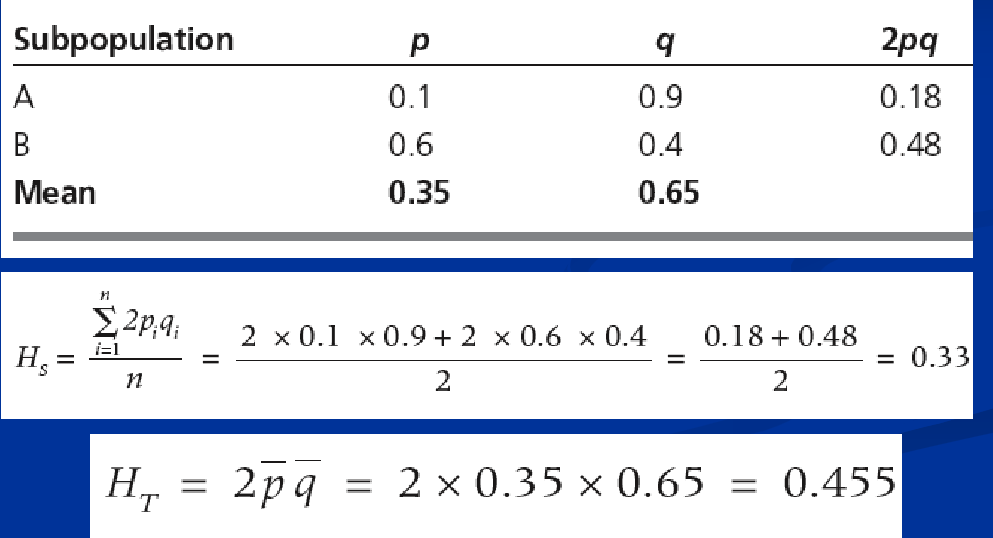
Interpretation of Fst (guidelines from Wright)
<.05 gene flow is likely higher
.05-.15 gene flow moderate
>.15 gene flow likely lower
Additional considerations for evaluating Fst
need to measure multiple genes - bigger sample size = more accuracy in measuring true genetic differentiation between subpopulations
size of subpopulation (effective population size- how many individuals are contributing to the gene pool)
sex ratios
level of endangerment
is isolation natural or induced by human activities
Mutation meltdown- sequence of events
frequency of mating between close relative rises
heterozygosity is reduced in offspring, reducing the ability of the population to respond to environmental change
semi-lethal recessive alleles are expressed in a homozygous condition
fecundity reduced
mortality increases
effective population size becomes even smaller, amplifying the whole process
Muller’s Rachet
a process in which, in the absence of recombination, results in an accumulation of irreversible deleterious mutations
management solutions for mutational meltdown
promote gene flow (corridors, translocations, ex-situ conservation)
exponential population growth key model
dN / dt = rN
dN/dt - he rate of change of the population size (N) with respect to time (t). It essentially tells you how much the population is growing at a given moment
r- per capita rate of increase
N- the population size at a given time
a conservation biologist must know (population level):
a conservation biologist must know:
the number of individuals in the current population
demographic information regarding the population
the trend in population size
an estimate of the immediate risk of extinction (or of the population’s viability- PVA)
IUCN Categories based on species viability
extinct (beyond reasonable doubt, the last individual has died)
extinct in the wild (survive only in captivity and/or naturalized populations)
critically endangered (considered to be facing an extremely high risk of extinction)
endangered (considered to be facing a very high risk of extinction in the wild)
vulnerable (considered to be facing a high risk of extinction in the wild)
near threatened (do not currently qualify for a threatened category, but are close in the near future)
least concern (do not qualify for a threatened category)
data deficient
perturbations (disturbance) to populations
deterministic factors: those that affect the population in constant relation to the population size (density dependent control factors when populations are near or at K)
stochastic factors
genetic: genetic variability, inbreeding, mutation meltdown
environmental: natural catastrophes, unpredictable, density-dependent impacts on a population
demographic: lag phases in population growth, changes in sex ratios, number of mature individuals, Allee effect and effective population size
The extinction vortex
extrinsic factors (habitat destruction, pollution, overharvest, invasive species) cause population to shrink to low numbers >
small, isolated population >
inbreeding and drift reduce variability and individual fitness, population declines >
demographic stochasticity, environmental stochasticity, allee effect further reduce population size >
repeat downward spiral to extinction
population count
quadrats, transects (botanical)
capture-recapture methods
the lincoln index
N- number of individuals that live in the study site (population at time t)
n1- number of individuals captured during the first round of captures
n2- number of individuals captured during the second round of capture
m- number of marked individuals that were captured during the second round

Mark-recapture assumptions of the model
no effect of marking on the probability of recapture
no effect of marking on survival
mixing of marked and unmarked individuals
captured individuals are representative of the whole population
closed population model
marks are not lost
Sampling techniques: Simple Random Sampling (SRS)
strengths- best way to randomize sampling
weaknesses- assume homogenous distribution of population, some areas may be completely unsampled, sample size considerations
Sampling techniques: Stratified Random Sampling
best in a non-homogeonous environment
beta diversity level studies
utilize simple random sampling with equal quadrats in each type of area
Sampling techniques- Systematic Sampling
random start, every x paces, every x tree, across a transect, etc
measuring toward a system with constant rate of sampling, less random
watch out for pseudoreplication ( don’t want to count the same individual more than once!!)
The Allee effect
populations/species can get stuck in a lag phase
fecundity drop off after large population because of carrying capacity
analogy= empty club, no one stays
ex: puffins
what factors and characteristics of a population contribute to its effective population (Ne)
absolute population size
uneven reproduction effort across individuals
sex ratio
population fluctuation over time
The effect on Ne of unequal sex ratios
Ne = (4NmNf) / (Nm + Nf)
The effect on Ne of population fluctuation over time
Ne = t / Σ (1/Nti)
t: number of generations (time steps)
Predicting how populations change through time
what will they do in the future
age-structure data = qualitative, typically human
age/staged data = modules using linear algebra
typically used for human populations, very difficult to determine with wildlife
age-stage based models of population growth
age-based
stage-based (egg, larvae, pupa, adult)
size based (small, medium, large)
Markov Chain
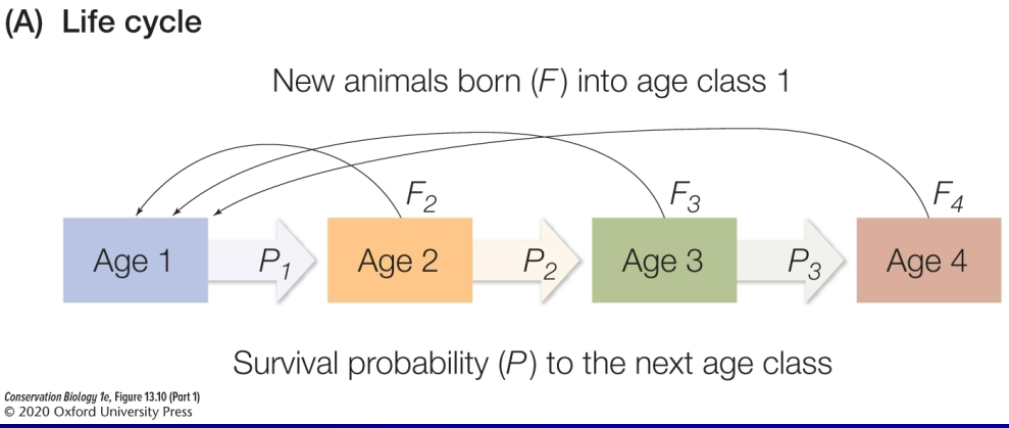
Age-based model of population growth
= 1: population will stay the same into the next time step
< 1: percentage decrease in the population (ex: .97= 3%)
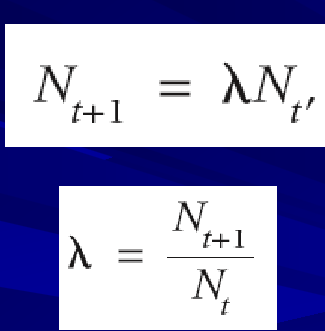
age-based model assumptions
population shrinks or grows at a constant rate (no population controls)
deterministic population dynamics (no good years or bad years)
homogenous individuals (all have the same reproductive success)
Leslie Matrix
*(how it fits together with the markov chain, must be able to plug into either), THEN plug in for lambda
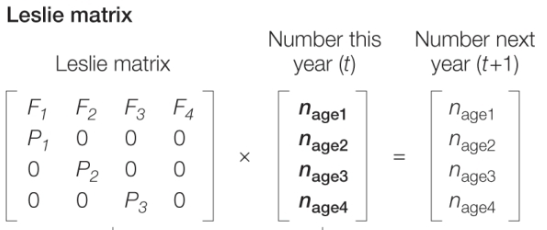
Minimum viable population
the population for any given species in any given habitat that is the smallest isolated population having 99% chance of remaining extant for 1000 years despite foreseeable effects of demographic, environmental, and genetic stoachsticity
Population viability, essential pieces of info:
the current N
population trend “r” or lambda
degree to with “r” or lambda fluctuates over t
primary objectives of population viability analysis
organize existing data about a population of conservation interest (IUCN)
estimate relative risk to the population based on different environmental, demographic, and genetic factors
adaptive management of populations by comparing model predictions to actual population behavior- ongoing experiments and monitoring
PVA is a model, quality can be effected by:
the quality of the model’s data and appropriateness of its structure to the populations studied
level of uncertainty associated with the model’s results
the quality of review the model was subject to prior to its final form and publication
Equilibrium theory of island biogeography (who_
McArthur and Wilson 1967
species equilibria for
small islands far from colonizing source
large island far from colonizing sourve
small island near colonizing source
large islands near colonizing source
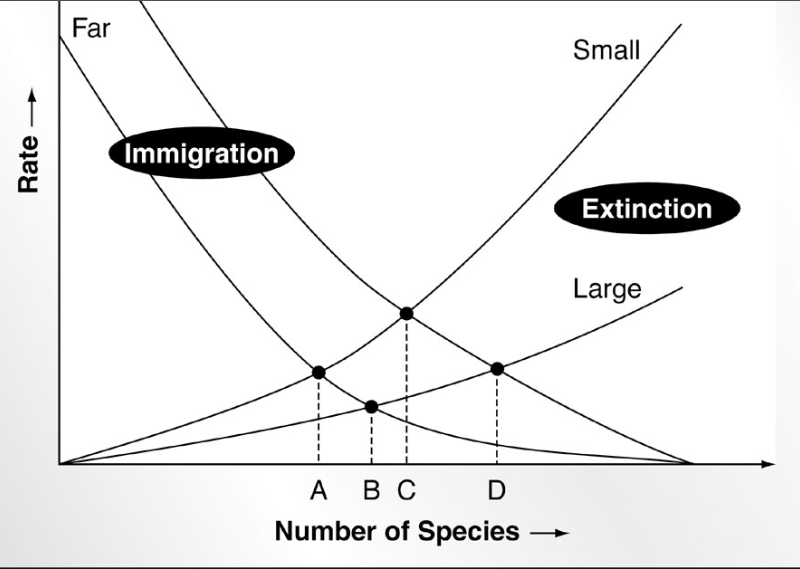
immigration rate is determined by:
distance of the island to the mainland
number of species in the mainland pool that have not established themselves on the island (species richness matters)
probability that a given species will disperse
extinction rate (on an island/patch) determined by:
the area of the island
the number of species present on the island (compression hypothesis)
probability that a given species on an island will go extinct (generalist vs specialist species)
habitat loss
the complete elimination of habitat along with their biological communities and ecological function
isolation
potential barriers to gene flow
fragmentation
process by which larger, continuous habitats become subdivided into a greater number of small patches
edge habitats/ecotones
mark the transition between two different habitats
leads to edge effect dynamics (40% loss of habitat = 60% loss of interior habitat)
consideration of natural edge habitats vs anthropogenic edge habitats
edge effects
suite of physical and biological changes that tend to occur at habitat patch edges
can potentially negatively impact diversity
additional factors:
changes in water regimes (from moist to xeric soils)
changes in biotic interations
wind, drought, fire, light (could be positive), nitrogen/nutrients
Faunal Relaxation (stages and who’s theory)
Newmark = LESS EXTINCTIONS WITH MORE LAND
initial exclusion
extirpation due to lack of essential resources
perils of small Ne- genetic demographic, and stochastic problems
deleterious effects of isolation- rescue effect decreases (gene flow)
ecological imbalance (leads to continued decreases in “s”- species richness)
Andrewartha and Birch (1954) metapopulation
a natural population occupying any considerable area will be made up of the number of local populations
Huffaker (1958)
mites and oranges experiment of habitat and non-habitat
Levins (1970)
first definition of metapopulation (father of metapopulation theory)
“any real population that is a population of local populations which are established by colonists, survive for awhile, send out migrants, and eventually disappear”
Levins basic population theory model
C- colonization
E- extinction rate
persistance at a patch requires that C > E
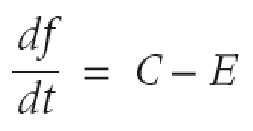
effects of colonization on extinction (do not need to know formulas, just how one affects the other
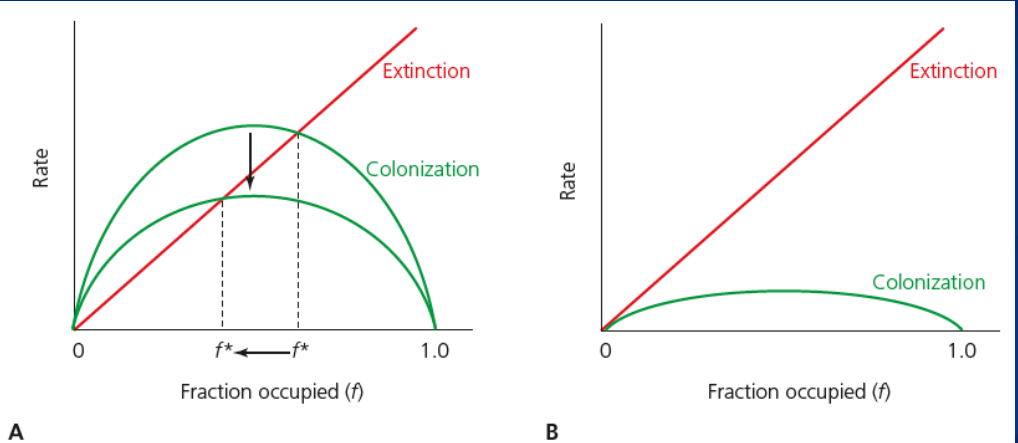
types of metapopulation
classic metapopulation (Levins)
mainland-island metapopulation (Boorman and Levitt)
nonequilibrium metapopulation
patch-population (panoptic)
directed landscapes
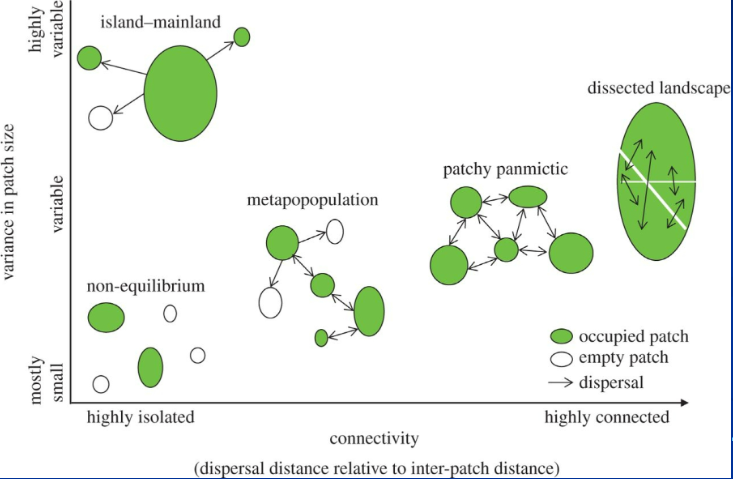
Conservation Lessons from metapopulation dynamics
sites that are currently unoccupied may be essential for the long-term persistence of the metapopulation
reduced disperal success can cause a metapopulation to become extint
a metapopulation can become extinct long before all of the habitat patches are destroyed
the arrangement and connectivity of patches can be just as important as the absolute amount of habitat that remains
3 C’s of Managing Fragmentation and metapopulations
connectedness (physical linage between habitats)
connectivity (measures the processes by which subpopulations of organisms are interconnected into a functional demographic unit)
corridor (linear landscape element that provides for movement between habitat patches (rosenberg et al. 1997)
What is the difference between a peace park and a paper park?
A peace park is a transboundary protected area that is formally dedicated to international cooperation and peace. A paper park, in contrast, exists only on paper, lacking effective implementation of conservation measures and often suffering from encroachment,resource extraction, and other threats due to insufficient funding, staffing, and political will.
Examples of current peace parks
Great Limpopo Transfrontier Park (South Africa, Mozambique, Zimbabwe), Kgalagadi Transfrontier Park (South Africa and Botswana).
What are major challenges to peace parks?
Political instability, differing national policies, lack of funding, community displacement, wildlife-livelihood conflicts, and military presence in some regions.
What is the IUCN’s role in peace parks?
IUCN supports the concept of Transboundary Protected Areas for Peace and Co-operation, promoting cross-border collaboration in biodiversity conservation.
What are CAMPFIRE and ADMADE? What problems did they face?
Community-based conservation programs in Zimbabwe (CAMPFIRE) and Zambia (ADMADE). Faced corruption, mismanagement, and unequal benefit distribution.
Who wrote The Ecologically Noble Savage and what is its argument?
Kent Redford; it critiques the romanticized idea that Indigenous people always live in perfect harmony with nature, which can lead to unrealistic conservation policies.
What argument is made in The Myth of Wild Africa?
authors Adams and McShane argue that African conservation must include development and benefit local people to succeed.
What were Integrated Conservation and Development Projects (ICDPs)?
World Bank-led efforts to align environmental conservation with economic development. Often failed due to weak implementation and lack of local involvement.
Who was Dian Fossey and what was Gorillas in the Mist?
Fossey was a primatologist who studied and protected mountain gorillas. Her memoir Gorillas in the Mist raised global awareness but her militant conservationism alienated locals.
Why were veterinary control fences used and what problems did they cause?
Used to stop disease transmission between wildlife and livestock. They disrupted migrations, harmed ecosystems, and hindered the formation of peace parks.
What was Anton Rupert’s contribution to conservation?
A South African businessman who founded the Peace Parks Foundation to promote cross-border conservation; advocated for 'Africa without fences.'
What did Robert Mugabe mean by “every species must pay its way to survival”?
Conservation should generate economic benefit to be viable, particularly through tourism or sustainable use.
How does poverty affect conservation in the developing world
People struggling with poverty often prioritize immediate survival needs over long-term conservation, leading to resource exploitation and resistance to top-down projects
What were initial problems with the Great Limpopo
Poor coordination between nations, lack of infrastructure, community displacement, and unresolved land rights.
What countries are involved in the Great Limpopo Transfrontier Park
South Africa, Mozambique, and Zimbabwe
Why are elephants considered important forest engineers?
They shape landscapes by knocking down trees, dispersing seeds, and creating habitats for other species
Why are elephants sometimes a problem for local villages?
They damage crops, compete for water, destroy infrastructure, and pose safety threats to people.
What is meant by 'psychobiological trauma' in elephants
Elephants experience emotional trauma, especially after poaching or culling, which affects their behavior and social structure.
What management techniques were considered for elephant overpopulation?
Culling, translocation, contraception, and habitat expansion through transboundary parks.
What is Coutada 16 and why is it important?
A former hunting concession in Mozambique; has potential for conservation and ecotourism as part of Limpopo.
What was the Great Elephant Indaba?
A conference to address the controversial topic of elephant culling in South Africa.
How are elephants in Kruger NP compared to elk in US wildlife refuges?
Both are protected megafauna that can overpopulate and cause ecosystem imbalance without predators or management.
How are ranchers in Catron County like villagers in Southern Africa?
Both experience wildlife-related conflicts and resent government conservation mandates that affect their livelihoods.
How did Anton Rupert’s death affect the PPF?
it created a leadership vacuum and stalled the momentum of peace park initiatives.
Why did Limpopo ultimately fail?
Due to unequal benefits, South African dominance, poor community engagement, land disputes, and criticisms of 'economic imperialism.'
What was the original purpose of the Giriyondo Gate and what happened instead
It was intended to allow wildlife migration and ecotourism, but ended up mainly facilitating vehicle traffic and border crossing.
What is the Transfrontier Conservation Area Route (TFCA), and what are its problems
A cross-border tourism and conservation route. Critics argue it is more about marketing than real conservation, and it lacks community benefit and ecological planning.
What countries are involved in the Lubombo Transfrontier Conservation Area (TFCA)
Mozambique, South Africa, and Eswatini (Swaziland)
Why was the Lubombo TFCA more successful than Limpopo?
It involved local communities from the beginning, had unique attractions per reserve, created jobs, and built community support
How did Roelie Kloppers link conservation to poverty alleviation?
He focused on job creation, tourism development, and empowering communities as stakeholders in conservation
What was the conflict between Tembe and Ndumo (the "Little Okavango")
Tembe was successful and inclusive, while Ndumo faced conflict due to displacing local people without adequate compensation or involvemen
What is the Bhekabantu Community Conservation Area
A locally managed reserve formed through community-driven conservation efforts, showing a successful grassroots model
How does the TFCA route differ from the Lubombo Tourism Route
the TFCA route emphasized ecological connectivity; the tourism route focused more on marketable travel experiences and profit
What is the Royal Jozini Big Six, and what analogy is used to describe it?
A luxury private development likened to Walt Disney World; it's a challenge to Lubombo’s inclusive model due to exclusivity and wealth-based access.
What countries are involved in the Kavango-Zambezi (KAZA) TFCA?
ngola, Botswana, Namibia, Zambia, and Zimbabwe.
Why is the Okavango Delta important to the KAZA project?
It is the chief water source and provides vital ecosystem services like flood control, habitat, and tourism.
What promises were made about KAZA’s approach to conservation?
It would include local communities, offer integrated development plans, and promote sustainable tourism.
Why is Botswana considered the economic anchor of KAZA
Botswana has stable governance, strong tourism infrastructure, and a proven track record of conservation success.
Why are crocodiles considered keystone and indicator species in the Okavango Delta
hey reflect the health of aquatic ecosystems and play critical roles in maintaining ecological balance.
What did Alison Leslie, Kevin Wallace, and Audrey Detoeuf-Boulade’s research reveal about crocodile populations?
sing mark-recapture and stage-based modeling, they showed population declines linked to habitat loss and environmental stress
What are the multiple roles of the Krokovango Crocodile Farm?
It serves agriculture (crocodile farming), supports wildlife conservation, and provides research opportunities—linking economy, environment, and education
Who is Mike Chase, and what is his view on KAZA
Founder of Elephants Without Borders. While originally supportive of KAZA, Chase has grown critical of its delays and lack of follow-through on inclusive goals.